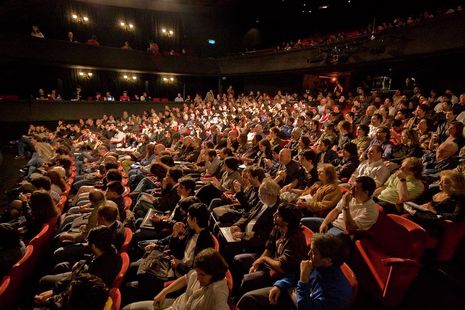The struggle to symbolise: The Father and the Assassin
Angus Harron reviews The Father and the Assassin at the Olivier Theatre

Bespectacled; enrobed in khadi dress, and leaning on a walking stick, the shadow of Mahatma Gandhi looms large over the history of postcolonial India. For Nathuram Godse, who, in the poster image of Indhu Rabasingham’s The Father and the Assassin, imposes himself boldly before the Mahatma’s outline, this is a shameful fact, and one he tried (and failed) to forestall with three bullets fired from a gun.
It is with the sound of these bullets that this play begins; with Gandhi’s death acknowledged from the beginning as the climax towards which the rest of the play builds. Godse, played by the brilliant Shubham Saraf, announces in the opening monologue, to an audience he intends to win over, that the scenes unfolding behind him are his version of how he became Gandhi’s assassin – or, as he prefers, his ‘murderer’; a word which, he explains, strips the victim of the ‘high status’ which the word ‘assassin’ accords them. Beneath and within the historical events depicted on stage there is a simultaneous exploration of how uncontrolled bitterness becomes anger and how anger incensed by ideology unleashes a person’s capacity for violence. Godse is the audience’s guide through both the history and this study of human nature, and the charisma brought to his role by Anapuma Chandrashekar’s script and Sharaf’s interpretation of it makes him a relatable, likeable character – one whose descent into villainy is thus meant to challenge our perceptions of ourselves.
“Chandrashekar’s Godse is therefore a young person entirely confused about his identity and desperate”
The arc of Godse’s life intersects with the story of India’s independence movements, a complex history that Rabasingham unspools intelligibly using Gandhi’s satyagraha movements in 1920, 1930, and 1940 as signposts. First, however, Godse’s narration takes us back from the 1948 murder – which occurred just after India and Pakistan were made independent nation-states – to 1910s Maharashtra, where Godse was raised as a girl by parents who believed, after their sons died young, that any male children we bore were cursed. Chandrashekar’s Godse is therefore a young person entirely confused about his identity and desperate, after discovering that he is biologically a boy, to discover and assert his manhood. Identity becomes a motif for Godse throughout the play as he struggles to understand who he is and what he believes in.
Identity crisis leads the young Godse to Gandhi, played by Paul Bezely, whose civil disobedience against imperial laws had already made him the ‘Father of the Nation’ and the figurehead for the Indian National Congress’s negotiations for greater self-government within the British Empire. Godse, like scores of his compatriots, becomes enchanted by Gandhi’s seemingly indestructible doctrine of ahimsa, which taught that a person transformed both his own heart and that of his enemy by non-violently resisting anything which contravened their sense of injustice.
After a personal tragedy, Godse becomes disillusioned with ahimsa, believing it to be a cowardly form of resistance that meekly swallows injustice rather than spitting in its face. Thinking himself deceived once again by a paternal figure, the enraged Godse immerses himself in the antithetical teachings of Vinayak Savarkar, an infamous Hindu nationalist. Savarkar’s intolerant ideology – which taught that religious minorities and especially Muslims threatened the unity of India because their holy land was located elsewhere – fuses with Godse’s rejection of ahimsa and creates a dangerously intolerant and angry man out of our previously jocund narrator.
“Rabasingham [...] uses flashing lighting and the flailing of bodies to communicate the violent disagreement that Partition generated”
Costume and choreography are used effectively in the play’s climactic scenes, with the former demarcating Gandhi from Congress politicians as they debate how to deal with the Muslim League’s demands for an independent Muslim state beside independent India. Rabasingham does not dwell on these discussions, however, and instead uses flashing lighting and the flailing of bodies to communicate the violent disagreement that Partition generated. Godse, contriving to blame Gandhi for this chaos, and to finally assert himself as a meaningful human being, kills the man he once adored in a purported attempt to stop him from damaging the character of Hindu India any further. By this act of patricide, Godse hopes to assert his – and Savarkar’s – vision for India over Gandhi’s; and to show the superiority of self-assertion over self-sacrifice, and violence over suffering.
Chandrashekar reserves her most powerful writing for Godse’s chilling attempt to justify his actions. Gandhi, returning on stage as a figment of Godse’s troubled imagination, laughs in the face of Godse’s belief that his violence served the greater good, underscoring Gandhi’s perpetual challenge to humanity that noble ends must never be sullied by the means. Before he is executed, Godse speaks directly to conflicts of good and evil in the souls of his audience, declaring before his execution, “when tomorrow’s battles are fought with greater weapons… you will need a Godse, and I will rise”. Chandrashekar’s implication: we must never let him.
 News / Pembroke to convert listed office building into accom9 December 2025
News / Pembroke to convert listed office building into accom9 December 2025 News / Gov declares £31m bus investment for Cambridge8 December 2025
News / Gov declares £31m bus investment for Cambridge8 December 2025 Features / Searching for community in queer Cambridge10 December 2025
Features / Searching for community in queer Cambridge10 December 2025 News / Uni redundancy consultation ‘falls short of legal duties’, unions say6 December 2025
News / Uni redundancy consultation ‘falls short of legal duties’, unions say6 December 2025 Lifestyle / Into the groove, out of the club9 December 2025
Lifestyle / Into the groove, out of the club9 December 2025









